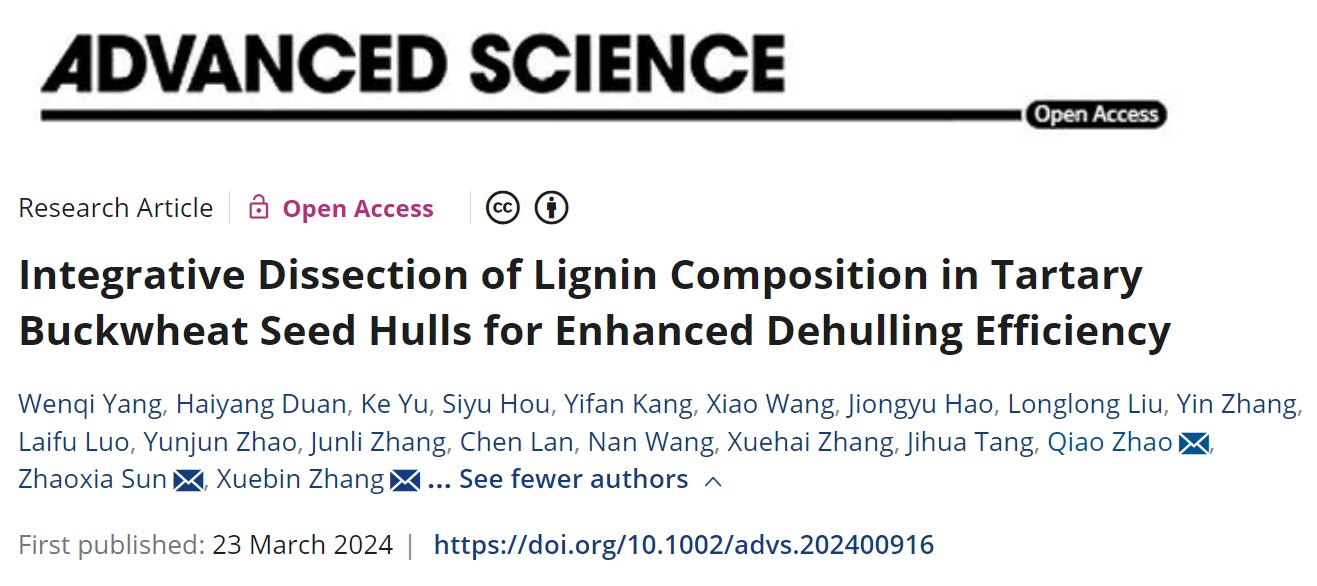
Lignin, a key factor in plant adaptation after landing, enhances the mechanical strength and hydrophobicity of plant cell walls, thus supporting the growth and water transport of the parts of plants on the ground. Lignin consists of three lignin monomers, p-coumarol, feruol and mustard apol, to form polymers with rich intermolecular chemical bonds. In the long process of evolution, plants have evolved with lignin with special chemical components and physical and chemical properties to achieve different biological functions.
Tartary buckwheat belongs to Polygonum family, which originated in southwest China and has a long growing history. Tartary buckwheat is rich in flavonoids such as rutin, and has the healthcare effects such as reducing “three highs” (high blood pressure, high blood sugar and high cholesterol). It is an important functional food crop. Its functions were recorded in the Compendium of Materia Medica, “strengthening the intestines and stomach, boosting strength and spirit, benefiting the ears and ears, clearing the filth from internal organs”. In the Shennong’s Classic, it is called “the king of cereals and grains”. With the increase of people’s demand for nutritional value of foods, Tartary buckwheat and its products are increasingly favored by consumers because of their unique nutritional value and health benefits. Unlike most cereal crops, Tartary buckwheat grains are wrapped by very hard hulls, and their main components may include cellulose, hemicellulose and benzene ring polymers with UV absorption and hydrophobic properties, such as lignin and tannin, but there are few detailed reports on the studies of its chemical composition. Tartary buckwheat originated from the high altitude regions with strong ultraviolet radiation. The lignin composition of the grain hull during long-term evolutionary selection can effectively protect the seeds from strong ultraviolet damage, and its hard hull can protect the seeds from digestion by birds, so the retention of the hard hull is the result of evolutionary selection. However, this thick and hard hull is difficult to peel off the seeds, hindering the dehulling process, and seriously restricting the production and economic benefits of Tartary buckwheat.
Recently, the research team led by Zhang Xuebin of Henan University joined hands with the research team led by Sun Zhaoxia of Shanxi Agricultural University, and the research team led by Zhao Qiao with Shenzhen Institute of Advanced Technology, Chinese Academy of Sciences, published a research paper entitled “Integrative Dissection of Lignin Composition in Tartary Buckwheat Seed Hulls for Enhanced Dehulling Efficiency” in the internationally renowned journal Advanced Science (Top of Zone 1, IF15.1), which revealed the correlation of the unique lignin composition of bitter buckwheat hull and its hardness. The genetic basis for the composition of lignin in Tartary buckwheat was also analyzed.

Screenshot of the article
Link: https: / / doi.org/10.1002/advs.202400916
This study applied NMR (NMR) and tandem mass spectrometry (GC-MS) to analyze the lignin composition in each tissue of Tartary buckwheat. The results showed that Tartary buckwheat, as an angiosperms, whose hull lignin composition has the characteristics of gymnosperms, which is mainly composed of G units, while the S units are very low in content. The lignin units are connected by the β-O-4 ether bond as well as the C-C bond. In comparison, the latter has a shorter bond length and a higher bond energy. Compared with S units, G units tend to form C–C bonds, thus making the structure of lignin more compact. So is the unique lignin composition in the Tartary buckwheat hull related to its hardness? To test this conjecture, this study used 274 samples in the Tartary buckwheat population rich in genetic variation to explore the relationship between lignin composition and the physicochemical properties of its hull. Correlation analysis showed that S lignin content and S / G ratio were negatively correlated with the hull hardness, indicating that this highly characteristic lignin composition endowed Tartary buckwheat with a stiffer hull.

The domestication and screening of crops is in pursuit of a high yield, a high quality and easier management and processing. In Tartary buckwheat populations, S lignin content and S / G ratio of modern cultivated varieties are significantly higher than in wild germplasm and farmers’ varieties, and have softer fruit hulls. Selective elimination analysis revealed that the genes FtF5Hs and FtCOMTs, associated with the biosynthesis of S unit, had been selected in the domestication and modern breeding of buckwheat. Meanwhile, genome-wide association analysis of lignin components of buckwheat revealed that FtCOMT1 gene is closely related to S / G ratio, which is one of the main genes controlling the lignin composition of buckwheat. These results indicate that during the domestication and breeding of Tartary buckwheat varieties, the genes controlling the synthesis of S lignin precursor were selected and the lignin composition in the hull gradually tilted toward S lignin, thus reducing the hull hardness. The findings of this project provide important theoretical basis and genetic resources for improving the mechanical strength and improving the dehulling efficiency of Tartary buckwheat.
Professor Zhang Xuebin from the State Key Laboratory of Crop Stress Adaptation and Improvement of Henan University, Professor Sun Zhaoxia from Shanxi Agricultural University, and Professor Zhao Qiao from Shenzhen Institute of Advanced Technology, Chinese Academy of Sciences are the corresponding authors.
About the Laboratory of Zhao Qiao
Researcher Zhao Qiao, director of Synthetic Genomics Research Center of Shenzhen Institute of Advanced Technology, Chinese Academy of Sciences, an expert of National Major Talent Project (Youth), a winner of National Science Fund for Outstanding Young Scholars, and director of Guangdong Key Laboratory of Synthetic Genomics. In 2021 and 2023, he was selected among the top 2% of global scientists (jointly released by Stanford University and Elsevier Database). He is mainly engaged in studying metabolism and synthetic biology of plants. His current research interests include: (1) plant metabolism and related applications (biosensor, colored cotton, etc.); (2) artificial synthesis and application of plant chromosomes; (3) high-throughput metabolic pathway analysis based on machine learning. He has made a series of important achievements in related fields. In the past five years, he has published more than 10 research papers as a corresponding author (or co-author) in international professional journals including Science Advances, Molecular Plant and Nature Communications. For details, refer to the laboratory’s homepage: http: / / www.zhaoqiaolab.org/.
Talents Wanted
The research team led by Zhao Qiao is to recruit postdoctoral fellows with related research backgrounds such as medicinal botany, analytical chemistry, molecular biology, and professional research assistants in biology and medicinal botany. Research orientations of the talents to be recruited are as follows: (1) analysis of plant natural products pathway; (2) synthetic microbial flora of crops; (3) application of nanomaterials in crops; (4) synthesis and application of plant artificial chromosome. You are welcomed to email your resume (PDF) to us at ao.zhao@siat.ac.cn, with the resume and email title indicated with “Position to apply for-university name-major-your name”. For more details, please visit the link https: / / isynbio.siat.ac.cn/view.php?id=824.